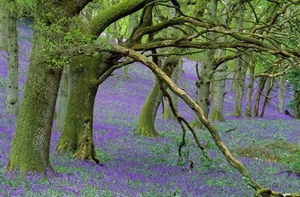Bluebells
 The month of April brings life back into our woodlands after the cold dark days of winter. Often it is the little splashes of yellow celandine, already flowering as the month starts, which first catch our eye. This makes us look more closely and we realise that the little purple dog violets are also in bloom and that it will not be long before the flower buds of the wood anemone open. But as April progresses it is the bluebell that steals the show, deep violet-blue swathes of shallow fragrant waters flowing around the tall trees – surely one of nature’s most dramatic scenes.
The month of April brings life back into our woodlands after the cold dark days of winter. Often it is the little splashes of yellow celandine, already flowering as the month starts, which first catch our eye. This makes us look more closely and we realise that the little purple dog violets are also in bloom and that it will not be long before the flower buds of the wood anemone open. But as April progresses it is the bluebell that steals the show, deep violet-blue swathes of shallow fragrant waters flowing around the tall trees – surely one of nature’s most dramatic scenes.
We often think that bluebells only belong in Britain, prompting names such as “English” Bluebell, but in fact they are found in Europe, albeit at much lower densities than here. The UK does hold at least 30% of the world population, however, the rest being located in various countries across Europe, but none occurring elsewhere in the world. This native bluebell is a very good indicator of ancient woodland and where it is found growing in the bottom of a hedge, it probably shows that this boundary was once part of a large wood, long since felled and turned into farmland.
The bluebell that I’m talking about here is Hyacinthoides non-scripta, but increasingly the Spanish bluebell, Hyacinthiodes hispanica, is becoming established across Britain. This invader is most commonly found in woods close to urban areas where they have been planted in gardens, parks and churchyards and have slowly spread into neighbouring woods. This slow colonisation is often speeded up by bulbs being included in garden waste dumped in the countryside. In fact, one in six broadleaved woods surveyed recently had Spanish or hybrid bluebells in them.
Does this spread of a foreign bluebell matter? Well, the problem is that our native bluebell is the less vigorous of the two species, so if it is not muscled out, then it often hybridises, resulting in a different “more Spanish” flower. Apart from losing our truly native plant, the other annoying fact about the Spanish bluebell is that it is scentless, meaning that one day perhaps, a walk through our woods at this time of year will be a visual-only experience.
So, all is not well with the wild flower that was voted “Britain’s most popular” in a poll conducted by the charity, Plantlife. Once again, we are managing to destroy the very things that we supposedly cherish so much.
Peter Thompson
Advisory

Download Peter Thompson's essential 26-page book, featuring beautiful photography and detailed profiles of Britain's wildlife
Download FREE >